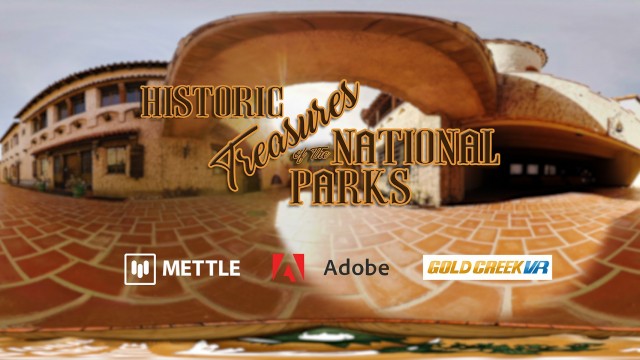VR/AR Saving America’s History | Historic Treasures of the National Parks | Gold Creek VR
Historic Treasures of the National Parks takes viewers on a 360/VR tour of America’s most famous, and sometimes endangered, historic sites!
When Death Valley National Park called on Gold Creek VR in 2016 they had a problem: Their most popular and historic tourist destination had been damaged in a flood. Scotty’s Castle’s long, colorful history and connection to a legendary tale of America’s Wild West, was going to be closed for repairs until at least 2020. The Park Service wanted visitors to experience Scotty’s Castle, while under repair and what better way than to create a historic VR/360 tour. Gold Creek VR Co-founders Ted Faye and James Markham Hall Jr., combined their love of history and documentary filmmaking with their considerable 360 production expertise to create “Scotty’s Castle”, the pilot episode for their new VR series “Historic Treasures of the National Park.”
One of the technical highlights – they created a one minute long moving shot through the courtyard at Scotty’s Castle with a custom motion control movement system. They calculated the path of the sun with an AR app and timed the motion control shot so that it ends with the sun peeking out from behind the corner of Scotty’s Castle as the camera comes to a stop. The integrated SkyBox 360/VR tools in Adobe CC 2018 gave them the right tools for post-production, so they could focus on storytelling.
To learn more about the American Ghost Towns series, we had the chance to talk with Gold Creek VR Co-founder James Markham Hall Jr.
Note: As of October 18, 2017, Adobe has fully integrated the SkyBox Suite of plugins into Creative Cloud. Adobe has more information about this integration on their website.
Q&A With James Markham Hall Jr. – Co-Founder of Gold Creek VR
Hello James! Can you give us a quick intro into the American Ghost Towns series?
Gold Creek VR is currently in production on several VR series including American Ghost Towns, Super Pups, and Historic Treasures of the National Parks. After exploring the VR marketplace, we realized there was an overwhelming lack of historic documentary content, so we decided to create American Ghost Towns as our first series.
Where did Mettle come into the workflow? How did it facilitate the production?
I’ve been using Mettle Skybox Studio from the beginning of our adventures in 360° video production. After evaluating other products with lackluster support, I was fortunate to come across Mettle. I contacted Chris Bobotis (Now Director of Immersive at Adobe) about adding a Nadir Patch to our videos and within minutes, we were on an Skype Audio call where he took control of my computer and walked me through the process step by step!
Not only was the software AMAZING, but the fact that someone as busy and talented as Chris would stop everything and take time away from his family to make sure that I understood how to use his product was astonishing. That’s the kind of customer service that inspires lifelong loyalty.
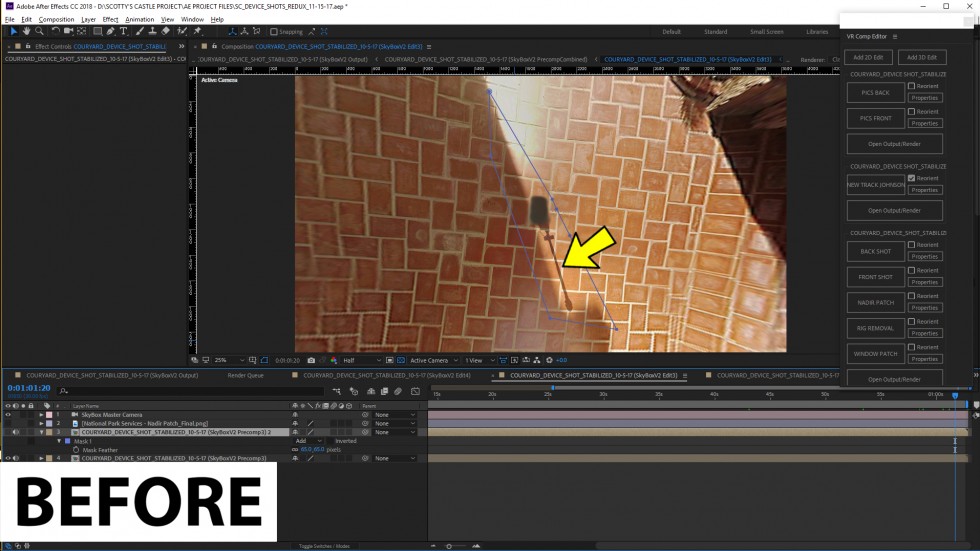
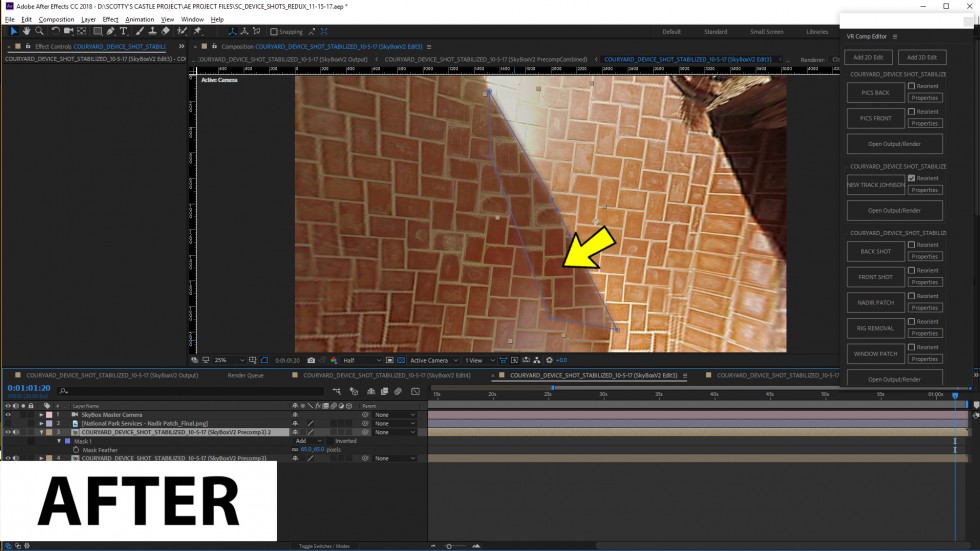
Before/After Camera shade removal
We noticed you used quite a few tracking shots for this series. How different is it to do those shots in 360°?
360/VR production is inherently more complex than standard 2D production. In “American Ghost Towns” and “Historic Treasures of the National Parks” we’ve incorporated long moving shots, utilizing our custom-built motion control movement system.
Creating a one minute long moving shot through the courtyard at Scotty’s Castle with our motion control movement system presented major challenges that the immersive tools in Adobe Creative Cloud enabled us to overcome. This long tracking shot required many corrections, including stabilization, parallax ghosting fixes, adding historic photos, shadow removal and capturing a “Sun Reveal” at the very end of the shot, which we used Augmented Reality to achieve, but more on that later.
Any other specific software or technique you used for this?
By doing such a long shot with the Freedom 360° camera system, which is a 6 GoPro rig, we were subject to some parallax problems in certain areas with image ghosting occurring throughout the course shot. The most noticeable of which were in the windows of the car port area.
To address these issues, I first utilized the 3D camera tracker in the VR Comp Editor to track the entire shot. Once that was completed, I performed a stabilization pass which smoothed the shot out considerably. The shot looked great, but the ghosting in the windows was still an issue. My approach to solving this was to export a still image of the windows from the edit comp view, painting out the ghosting in the windows using Photoshop and then adding the painted windows back into the motion tracked comp. I feathered the edges, tweaked the brightness, set a few key frames so that the window patch tracks along with the move and the final effect looks great!
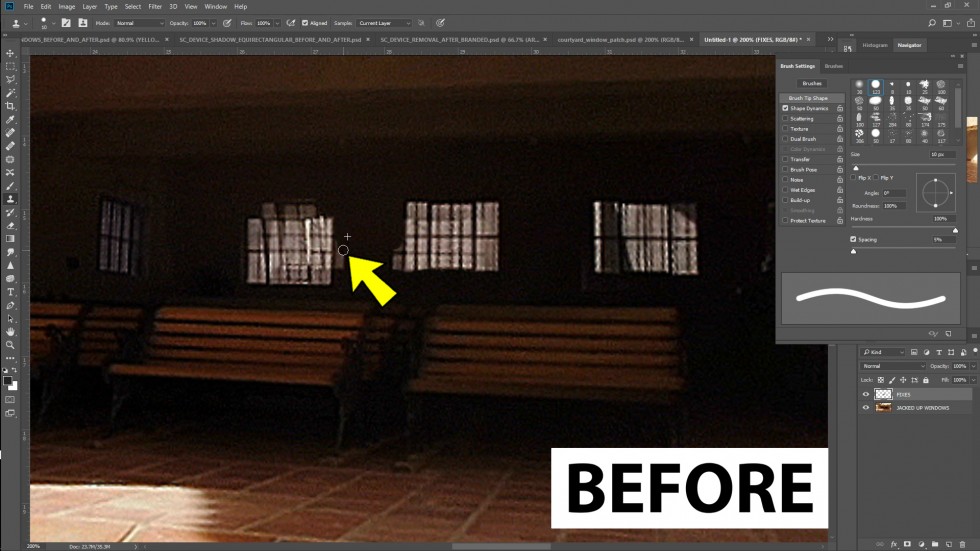
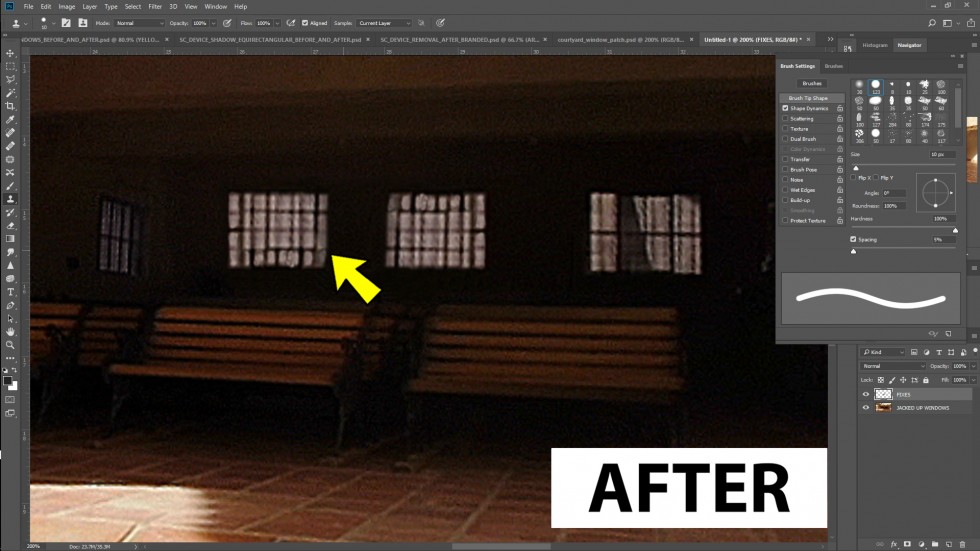
Before/After Parralax Ghosting on Windows
You also add a lot of 2D photos inside of your 360° shots. What’s your process to add them in?
Adding the historic photos was pretty straightforward. By assembling the rough edit in Premiere, I was able to determine the placement and timing of when the images would dissolve in and out, based on the narration. By taking timecode notes in Premiere, I was then able to place the historic images in the front and back views in After Effects, dissolving in and out at the precise moment, both front and back views perfectly in sync. During our initial location scout, we determined that the courtyard at Scotty’s Castle was the perfect place to do the longest tracking shot in 360/VR history.
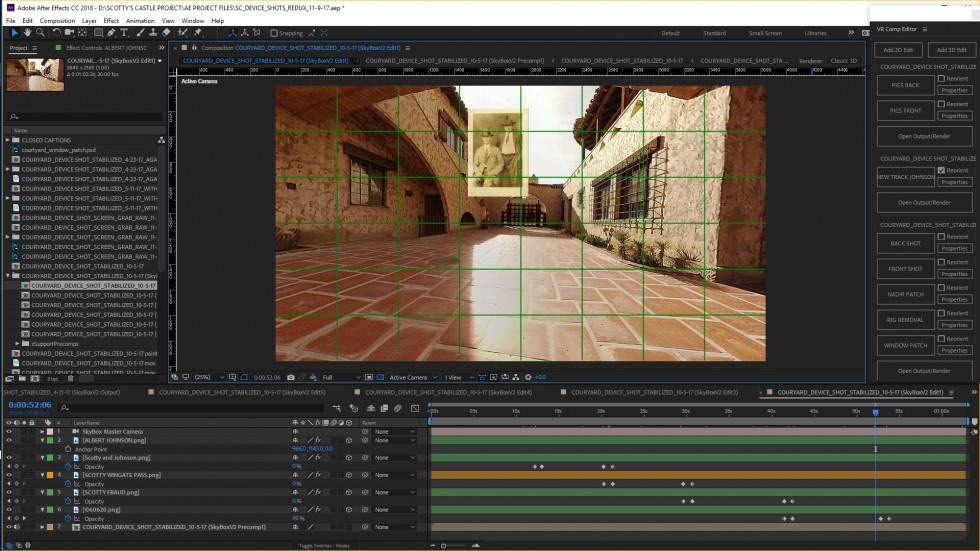
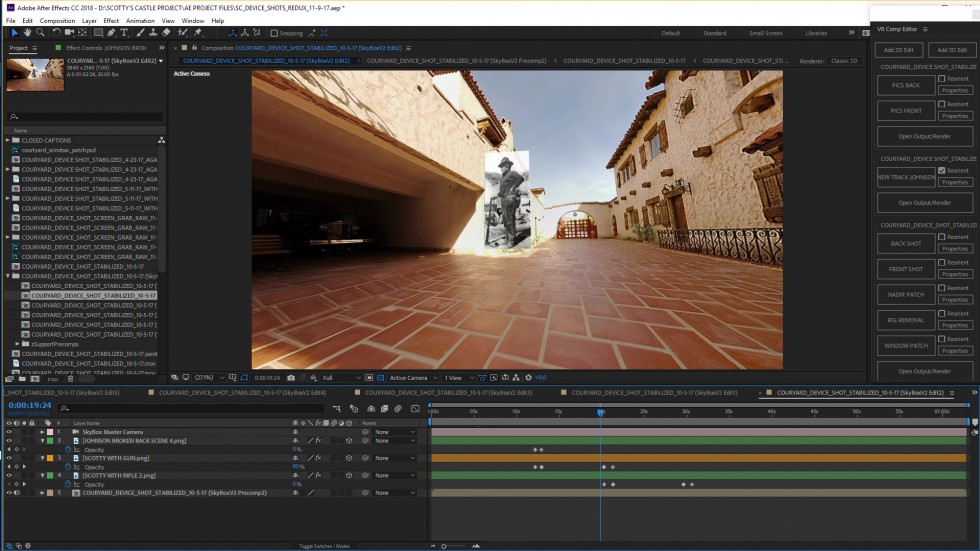
Adding a 2D image in 360/VR
The Longest Tracking shot in 360/VR History?
Yes! We knew that our motion control movement device could handle the task, but in order to put an exclamation mark on the camera move, we wanted to time it perfectly, so that just as the camera came to a stop, the sun would be revealed from behind the castle. To achieve this, we turned to an Augmented Reality app that I frequently use on feature films and television projects called LUMOS: Sun and Moon Tracker from Luminous Labs.
360° Before and After Sample Footage | Historic Treasures of the National Parks | Gold Creek VR
The AR app is free and allows you to approximate the position of the sun over time with beautiful augmented reality imagery which is incredibly accurate. It allowed us to narrow down the window of time in which the sun would be in the perfect position for us capture the moving shot with the sun peeking from around the corner of the building just as the camera creeps to a stop.
For extra stability, we set the motion control system to move the camera very slowly over the course of 12 minutes knowing that we would speed up and further stabilize the shot later. Based on the AR info we obtained from LUMOS, we determined that we’d have enough time for two attempts at this 12 minute moving shot before the Sun would move out of the optimal position. We initially wanted to shoot this shot on Day 1 of production, but we had an overcast sky, so we decided to knock out the bulk of our interior shooting first. Day 2 had perfect weather and our second take ended up being the winner, so that’s the take that actually made it into the show.
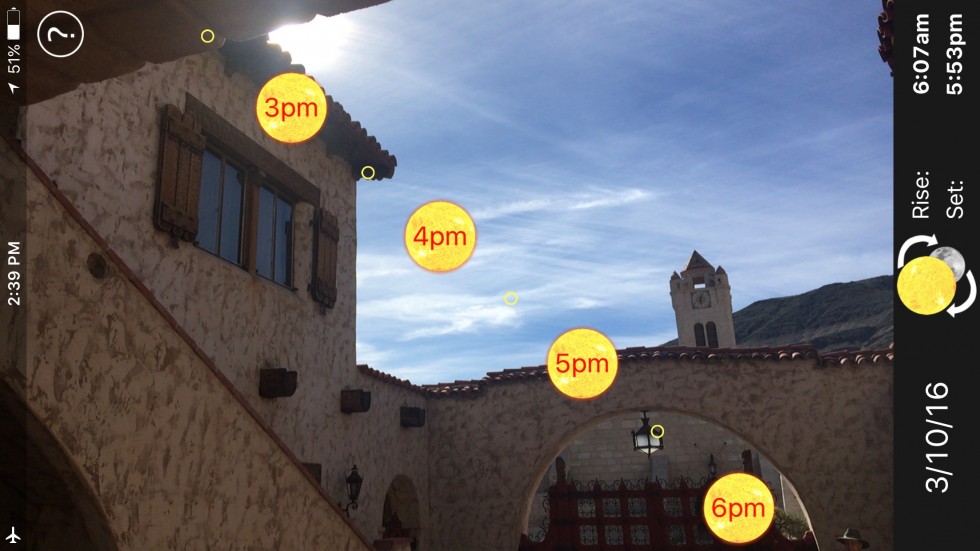
AR APP CALCULATES SUN PATH AT SCOTTY’S CASTLE
What do you think of the integrated SkyBox 360/VR tools for CC 2018?
The Skybox VR tools integrated into Adobe Creative Cloud suite allowed me to shoot with confidence. Knowing that I could make adjustments to stabilization, camera orientation, remove unwanted camera support shadows, add a rotating National Park Service nadir patch as well as historic photos utilizing the VR Comp Editor enables me to me to enjoy total creative freedom. Knowing that I possess the tools to execute this incredibly challenging 360° moving shot allowed me to singularly focus on telling the story in the most cinematic way possible.
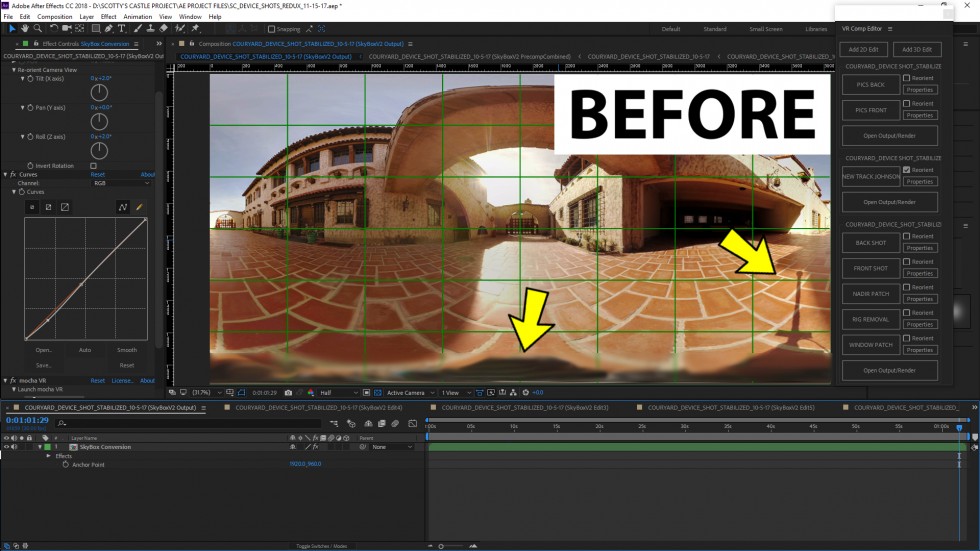
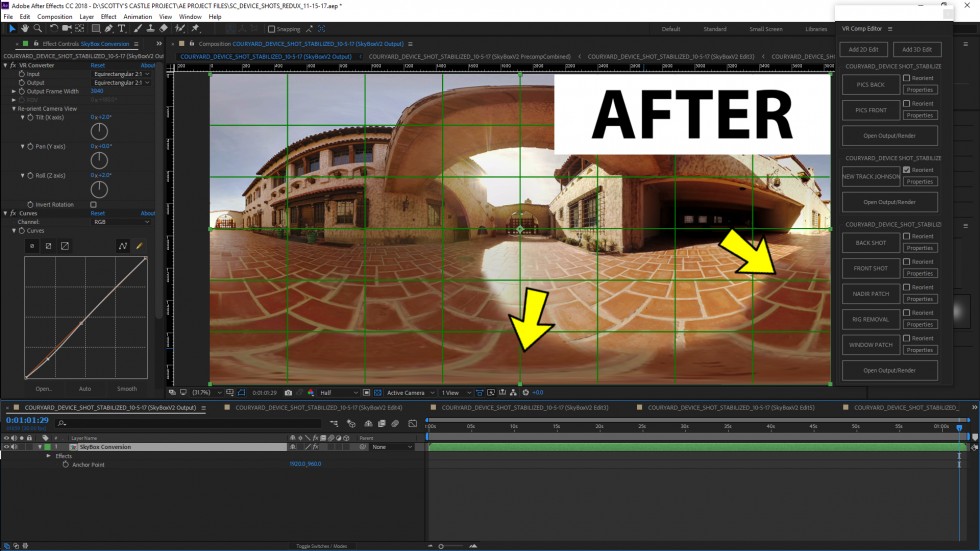
Before/After Rig Removal
What kind of hardware did you use for this?
“Historic Treasures of the National Parks: Scotty’s Castle” was captured using the Freedom 360 rig with GoPro Hero 4 Black cameras. This is an incredibly viable and very affordable method to capture 360 video at 8K resolution. Our primary edit suite on this project was an i7 6700K CPU, with 64GB RAM, NVIDIA TITAN X Pascal with SAMSUNG M.2 SSD’s on Windows 10.
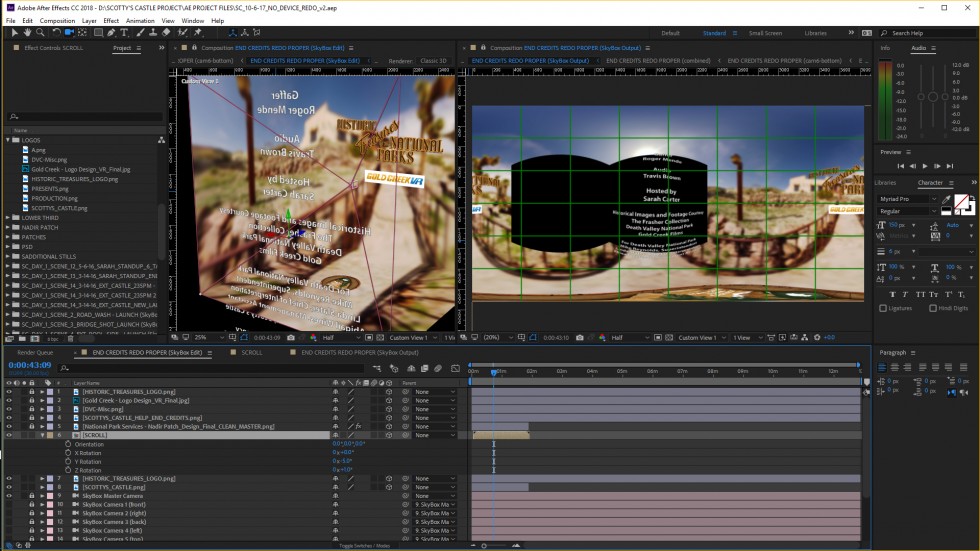
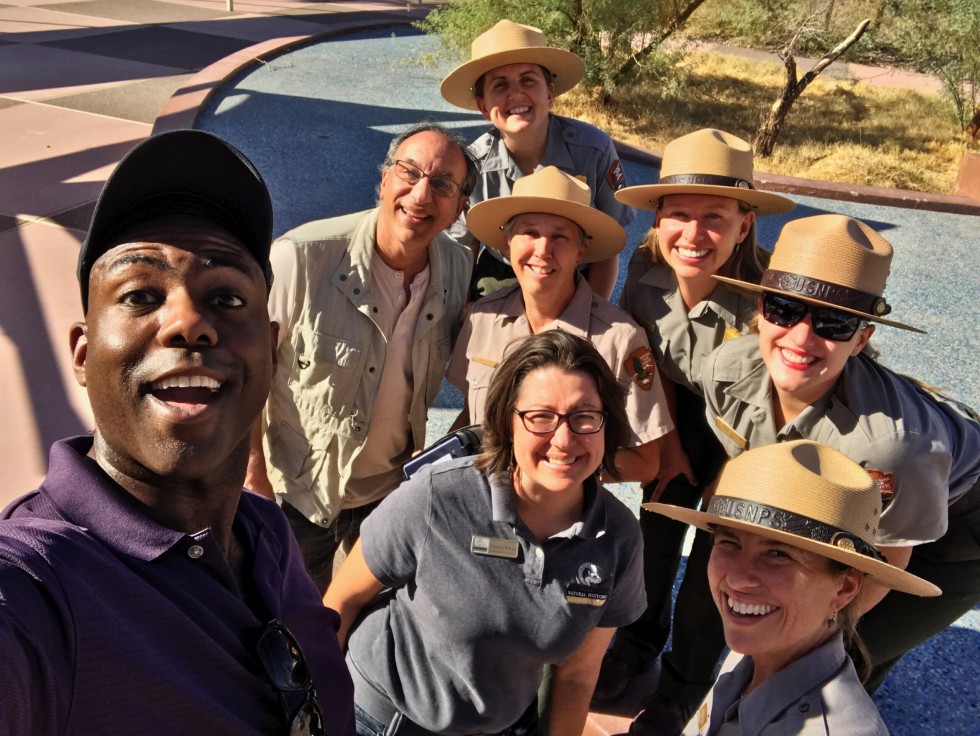
Selfie of James and Ted with the Death Valley National Park Rangers
As you know, the Skybox tools have been integrated inside the Creative Cloud. What does that means for VR creators like you?
Adobe CC 2018 integrates the impressive Skybox Studio tools directly into Adobe Premiere and After Effects. These tools combined with the ability to now edit 360 panoramic images in the new Photoshop CC allow us to achieve powerful results consistently on our VR series. I’m also beyond excited about the wonderful Adobe Immersive Environment in Premiere, it’s pretty amazing!
Thanks a lot James! We’re looking forward to seeing what you do next!
About Gold Creek VR:
Gold Creek VR was co-founded by Ted Faye and James Markham Hall, Jr. and produces the award winning series “American Ghost Towns,” “Super Pups” and “Historic Treasures of the National Parks.” Prior to working in 360/VR, their interest in history led them to produce twelve documentaries on the desert regions of California and Nevada (including Death Valley), which were featured in a DVD box set entitled “Tales From Death Valley” distributed through Best Buy, Target, Walmart, Amazon and Barnes & Noble. They recently collaborated on SHOWTIME’s number one rated sports documentary “IVERSON,” a feature documentary on the life of NBA All-Star Allen Iverson, available on SHOWTIME, iTunes, Amazon, Google Play and NETFLIX.
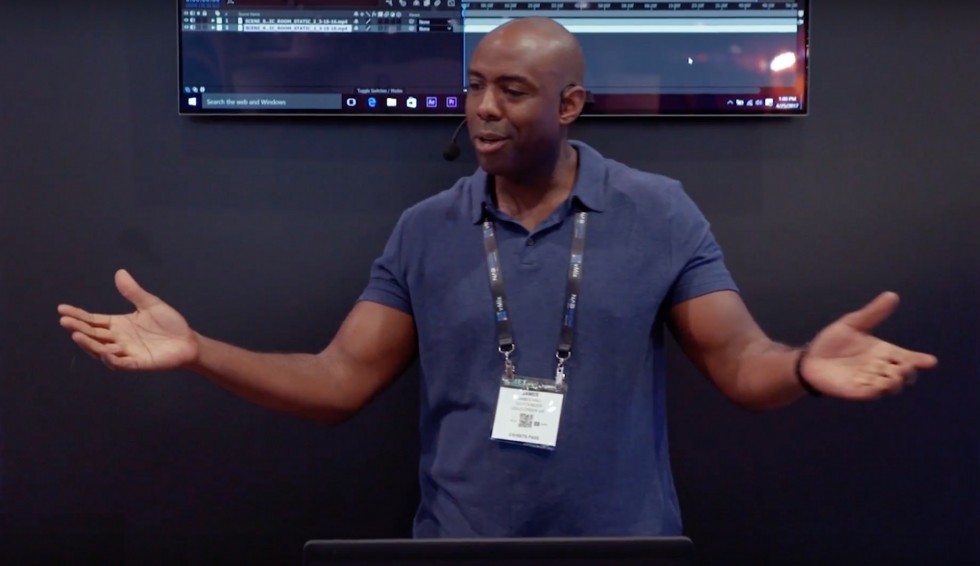
James Markham Hall Jr.
James Markham Hall, Jr. is a graduate of the North Carolina School of the Arts, School of Filmmaking and serves as a Director of Photography in the entertainment industry. James earned an Emmy nomination for his work on the A&E series “Intervention” and has been responsible for the Cinematography of programming on all the major television networks. He recently completed filming in Alaska for both Animal Planet and National Geographic in addition to completing feature films for Lifetime and Netflix.
